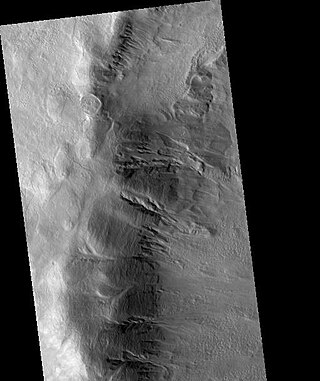Chincoteague (crater)
Crater on Mars From Wikipedia, the free encyclopedia
Chincoteague is an impact crater in the Cebrenia quadrangle of Mars, located at 41.5° N and 236.0° W. It was named after Chincoteague, a town in Virginia, US.[1] Chincoteague crater has a small central mound. Along the wall, a number of gullies are visible.
- Close-up of Chincoteague crater, as seen by HiRISE. Image close-up view of previous image. Note the gullies and associated landforms.
- Chincoteague crater, as seen by CTX camera (on MRO).
- Gullies on western wall of Chincoteague crater, as seen by CTX camera. Note: this is an enlargement of the previous image.
- A topographic map created using Mars Orbiter Laser Altimeter (MOLA) data. This map shows the relative elevation in 100 m (330 ft) elevation contour lines (dashed) and 500 m (1,600 ft) elevation contour lines (bold) with an average accuracy of each point is originally ~100 m (330 ft) in horizontal position and ~1 m (3 ft 3 in) in radius (Neumann and others, 2001). However, the total elevation uncertainty is at least ±3 m (9.8 ft) due to the global error in the areoid.
 Chincoteague crater, as seen by HiRISE. | |
| Planet | Mars |
|---|---|
| Coordinates | 41.5°N 236.0°W |
| Quadrangle | Cebrenia |
| Diameter | 37.0 km (23.0 mi) |
| Eponym | Chincoteague, Virginia, USA |
Gullies
Chincoteague crater displays gullies on its wall. Many ideas have been put forth to explain them. For many years, many researchers thought they were made by recent liquid water.[2] However, with more observations, other mechanisms became possible. It was observed that new gullies were forming today during the Martian spring when dry ice was able to sublimate (turn from a solid to a gas). Chunks of dry ice could accumulate in the cold winter months and then slide down when warmed. In the thin atmosphere of the planet they would ride on a cushion of gas that was coming off the pieces of dry ice.[3][4][5]
See also
References
Wikiwand - on
Seamless Wikipedia browsing. On steroids.




